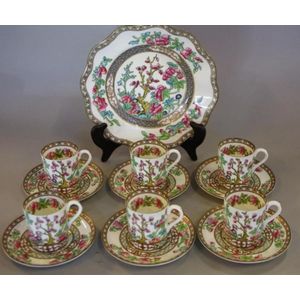Maling Lustre Ware Bowls Set
You must be a subscriber, and be logged in to view price and dealer details.
Subscribe Now to view actual auction price for this item
When you subscribe, you have the option of setting the currency in which to display prices to $Au, $US, $NZ or Stg.
- Lustre Ware - Ceramics that have been coated with metallic oxides and then fired, to give a metallic finish, using a similar technique to, and sometimes resembling the irridescent finish on glass. Colours produced included silver (using platinum), gold, pink, white, copper and cream. Lustre ware was first made in England in the late 18th century. In the 19th century, many Staffordshire potteries produced lustre ware including Crown Devon, Royal Worcester, Carlton Ware, and Wedgwood. A lustre glaze was used very successfully by Belleek, in Country Fermanagh, Ireland. Many of their wares displayed a nautical theme including shell shapes, dolphins, and mer-boys.
- Lustre Ware - Lustre decoration on ceramics is created by painting a thin deposit of metal oxide such as gold, silver or copper onto the surface, and then firing the item again, so that metal oxide forms a thin film on the surface. The finished effect is a shiny metallic surface. The technique was used in the 19th century by potteries such as Crown Devon, Grimwades, Maling, and Royal Doulton. However the best known use was by Wedgwood for its Fairyland lustre.
- Circa - A Latin term meaning 'about', often used in the antique trade to give an approximate date for the piece, usually considered to be five years on either side of the circa year. Thus, circa 1900 means the piece was made about 1900, probably between 1895 and 1905. The expression is sometimes abbreviated to c.1900.
This item has been included into following indexes:
Visually similar items

A pair of Worcester Flight Barr & Barr tea cups and saucers, circa 1820s, the Imari pattern footed cups with looped handles and saucers all with undulating gadroon moulded rims, decorated with a fenced oriental garden scene in a vibrant cobalt, green and i

Coalport coffee set, comprising 6 cups and saucers and 1 cake plate,

Seven Royal Doulton Aust gum trees items, including vase; pair lobed dishes; sandwich plate; cake plate; jam dish ; and butter dish; D5506. C. 1930s. Height 19 cm. (vase)

An opposite pair of Chinese famille rose plates. Decorated to each with four figures engaged in a domestic narrative surrounded by floor vases and tables with ornaments, pastel borders with brocaded diaper grounds, the outer border with three floral shaped
